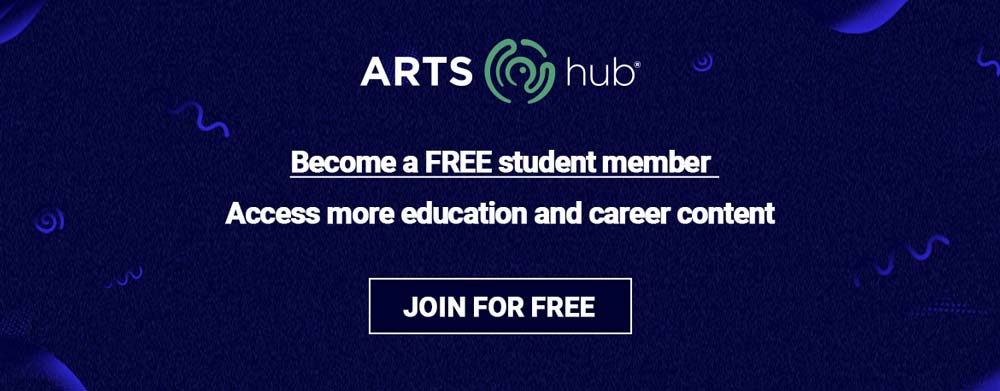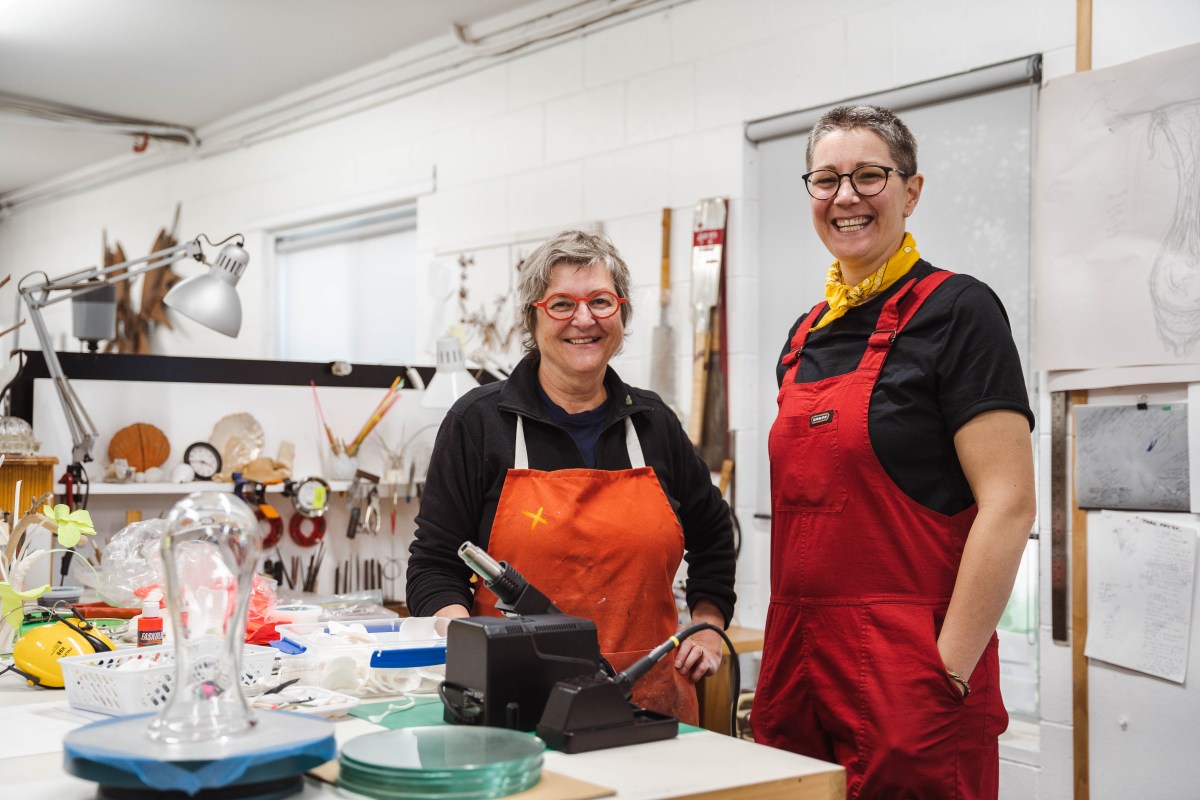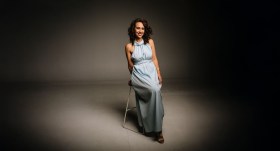The creative life involves far more admin, grant-writing and paperwork – and, ugh, taxes and self-promotion – than visual artist Oakey ever imagined when she retired from being a professional cricket player to attend art school.
With a focus on nature, ceramics, sculpture and the blending of different materials, Oakey is now an exciting emerging artist based on Kaurna Land/Adelaide. Her very personal solo exhibition, Deep Rest, is currently showing in Hahndorf as part of the Adelaide Fringe, and incorporates video, performance and sculpture.
But, in 2022, when Oakey sought out a professional mentor – established South Australian artist Catherine Truman – an important part of that process was being coached about those annoying, practical aspects of the artist’s life, alongside the challenges of maintaining stamina and self-confidence, and building an ergonomically healthy studio practice.
Truman, an artist working across the disciplines of art and science, is a co-founder and current partner of Gray Street Workshop. Widely exhibited nationally and internationally, with experience as a professional artist spanning more than four decades, Truman was able to offer Oakey her perspective, experience and encouragement.
The two artists were formally paired as part of the 2022 Guildhouse Catapult mentorship program. Guildhouse is South Australia’s peak body for visual art, craft and design. It has more than 1000 members. Through its Catapult mentorship program, Guildhouse offers multiple mentorships each year valued at $5000, for South Australian artists, craftspeople and designers to pair up. The mentoring process is not about outcomes or exhibitions, but to develop skills, realise projects and allow real, unhurried time for participants to consider and learn more about their practice. Significantly, applicants’ budgets must allocate payment for both mentor and mentee.
In addition, Catapult’s partnership with the University of South Australia involves research examining the longitudinal impact of mentorships on artistic careers over time, and participants of the program contribute to this ground breaking-research. (An interim report from the mentoring study can be found here.)
ArtsHub talksd to Oakey and Catherine Truman about the nitty-gritty of the mentoring process, their shared love of nature and what they have learned from each other – from the sublime to the mundane.
Oakey
ArtsHub: How did you come to be involved with the Catapult Mentoring Program?
Oakey: I applied for the program through Guildhouse after hearing other artists talk about their experiences. I had heard of and seen so many success stories and felt it was perfect timing to apply for a mentorship. I reached out to Catherine before applying and off we went!
Why do you think Catherine Truman was a good match?
I had been following Catherine’s practice for a while and I first met her at the Return to Earth symposium in 2021 as part of the Nature Festival here in the Adelaide Hills. We hit it off with a conversation about acorns and photoluminescent powder, I’m pretty sure!
I chose Catherine as a mentor for a number of reasons. I’m in awe of the depth of experience she has, having practised as a full-time artist for 40 years. I find her work deeply thought-provoking and meticulously created and, importantly, I felt we would be compatible as mentor and mentee.
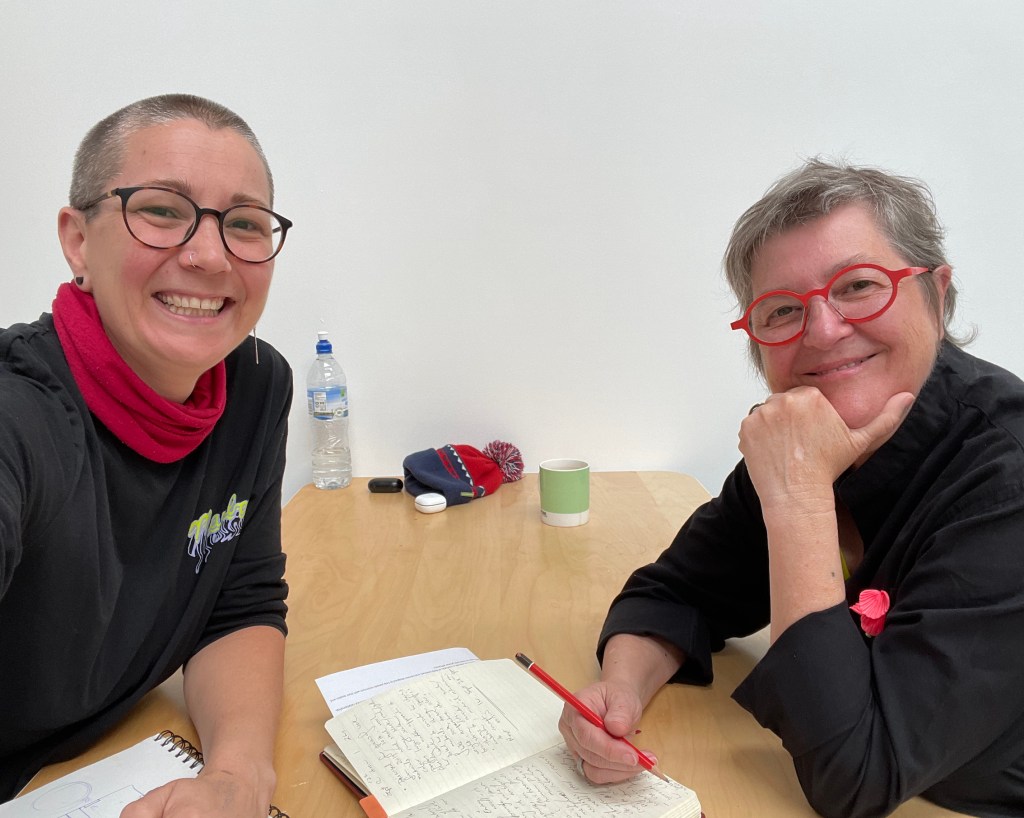
What were you hoping to gain from the mentorship process?
At the heart of it, I wanted to grow some confidence back. The last few years have been challenging and this led me to reflect more deeply on my practice and the direction I wanted to take. I work a few different jobs within the arts, which all tie in to my practice, but my main goal is to become a full-time artist. I take inspiration from a range of concepts and felt a mentorship with Catherine would help me solidify my goals and become more articulate around these ideas and themes.
Anybody who has listened to Catherine speak about her work notices how considered, concise and passionate she is. It’s so inspiring to hear someone speak to their practice so clearly. I was also seeking guidance on how to streamline my practice on the admin side of things, so I could spend more time creating. I mean, that’s the dream isn’t it? Ideally, I would love another eight months with Catherine where we deep dive in to materials. I’m lucky enough to know that we have an ongoing friendship now and I can reach out for advice or even just a cuppa when in need.
As part of the mentorship I also wanted to:
- review my current part-time practice and develop a meaningful and sustainable full-time practice
- develop sustainable health/ergonomic aspects of my practice and work environment (using the Feldenkrais Method)
- investigate ways of creating embodied experiences for the audience through the Feldenkrais Method
- delve deeper into exploring the art/science relationship
- focus on ways to generate professional opportunities and approaches to residencies in the art/science field (that is, an ANAT [Australian Network for Art and Technology] residency), and
- develop approaches to research, making, installation and audience engagement.
Read: The Artist’s Way – an invitation to change your life
What do you particularly like or connect to in Catherine’s work and process?
There are a number of crossovers in our practices – a main one being a deep curiosity in the natural world and our relationship to it, and the exploration of the intersection between art and science. Catherine’s practice is highly considered, intricate and varied, and I was curious how she achieves some of her most intricate work, and what materials she enjoys using. I’m interested in her approach to embodied movement for creative development and audience engagement, and how I can create an embodied experience for the audience within my own sculptural installations. We are also both obsessed with trees in every form!
Read: Me and my mentor: Britt Salt and Hannah Gartside
What kinds of meetings and contact were involved?
We had 12 one- or two-hour sessions over an eight-month period. The catch-ups varied between my studio and Catherine’s. At the time I was working within a loud metal workshop, so meeting in Catherine’s environment allowed us to have long conversations and frequently ran overtime as we had so much to share.
Practical sessions involved showing each other what we were working on. I particularly enjoyed Catherine showing me her process of using thermoplastics with glow powder to mould into leaves. Catherine came to both my old and new studio to help me work through the ergonomics of my working space, with her Feldenkrais training in mind. My practice is physical and repetitive and it’s important that my workspace is set up so I can use my body in a sustainable manner. I want to keep making art for a long time yet! We also explored how Catherine plans her exhibitions, sometimes years in advance, who she asks for support, and the big task of applying for grants.
What do you need most help or advice with as an artist?
Definitely the admin side of being a creative, more specifically grant-writing and taxes. This is a very common theme. I have to take weeks off work to write grants sometimes and it seems totally counterproductive.
What was the most important thing you learned in 2023, both from life and from Catherine?
I think 2023 was quite the ride for a lot of us! The main lesson I learned was to go with the flow and not take things so seriously. There’s obviously a time and a place, but I was at my happiest when I relaxed in my thinking and looked to the joy and wonder in both life and my practice. Making time to step back and see things in the moment. Catherine and I had many chats about this.
Catherine comes out with so many nuggets [of wisdom] it’s hard to choose one, but something she said that springs to mind from our very first session was to always strive to bring my ideas to their full potential. We have to compromise sometimes when it comes to space or time or money, but there is always a way to keep being ambitious and keep persevering.
What other kinds of mentoring have you most benefited from as an artist in the past?
I had a wonderful mentor in Roy Ananda for my ever first solo show. He guided me thoughtfully through the process and helped practically and hands-on. I really benefited from the one-on-one support. He was also there for me during install when I got the call from England saying my grandma had passed. I’ll never forget that, and I guess you never know what’s going to come up when you’re mentoring!
A year later, I was involved in a group public art commission here in Adelaide with Louise Haselton as our mentor. We were all friends and got along well, but it felt so important to have Louise as an anchor and sounding board. She has such a wealth of knowledge and made the experience thoroughly enjoyable.
Are there any aspects of the artist’s life and challenges that you wish were explored more in formal education?
Real life examples and strategies of how to live as an artist. Again, it comes down to the admin side of being an artist. Taxes, marketing, grant-writing, self-promotion etc.
What has been the most challenging part of building your career as an artist? And the most joyful or rewarding?
The most challenging part? Getting out of the way of myself. Acknowledging the self-doubting thoughts and trying to move on with confidence. Also, admin! The most enjoyable would be the actual making process, getting into the flow and seeing what develops. It’s just so exciting! On par with that is meeting other people in and out of the arts – hearing people’s stories and exploring the world. I’m grateful I can express my experiences through my art. I work as an arts installer and just love to meet new artists and curators.
Have you ever been a mentor yourself? And what would you like to give back to those coming up behind you?
I currently teach art workshops to children and adults, and would love to step in to the role of mentoring. I used to be an elite sportsperson, a cricketer, and know how potentially career-changing having the right coach can be. I used to be coach myself and have found it interesting to see the crossovers between sport and art. I’ve found the Catapult mentorship an incredibly enriching experience and, as my art career progresses, I am keen to share what I learn to those interested. I think it’s so important for us to support each other as artists. It can be tough out there and we can’t always go it alone.
Where can we see more of your work?
If you’re in Adelaide for the Fringe this year I have a solo exhibition, Deep Rest, showing at the Hahndorf Academy from 3 February to 17 March. The show explores a recent trip to Yaegl Country, northern NSW, where I spent four days and nights solo in the bush with only water and sleeping gear. It was a quest to find deep rest in the arms of nature. Otherwise head to my Instagram or my website.
Catherine Truman
ArtsHub: How did you come to be involved with the Catapult Mentoring Program and with Oakey?
Catherine Truman: I have been involved as a mentor since the inception of the Catapult program [first run in 2018] and am an enthusiastic advocate. Originally, I was approached by a young artist to see if I would work with her to consolidate and expand her approach to her practice. I saw it as a unique opportunity to share experience and participate in a meaningful exchange.
Oakey approached me to see if I’d be interested in working together. We’d met through another project and, through that exchange, we both felt we were compatible to pursue the mentorship. Mentoring is an intimate process of give and take, so it’s always preferable, if possible, to get to know each other a little before both of you enter into the commitment. A studio visit and a casual chat over a cuppa usually marks the beginning.
What were you hoping to gain from the mentorship process, and is it important to you that formal mentor programs pay artists for their time?
I gain immense satisfaction when I see anxiety and fear dissipate over time as someone gains more of an understanding of their own unique approach to making art for a living. As an established practitioner I believe that exchanging professional skills and experience across the broader arts community is important for the growth and evolution of the creative sector. As such, I am very appreciative of the opportunity to engage in mentoring programs like Catapult.
Artists are commonly expected to work for nothing. Mentoring is a formal professional exchange of experience and expertise and being paid for the work we do is vital. After all, mentorships should fundamentally reinforce the value of arts practice.
What did the mentorship process look like for you, in a practical sense?
Oakey and I met for the 12 one- and two-hour sessions over the duration of the mentorship at Gray Street Workshop and at Oakey’s studios at George Street, Thebarton and later at Central Studios in Kent Town. Our sessions followed Oakey’s well-planned Catapult schedule, except when we both decided to address immediate issues in her practice as they arose. The ability to respond and remain flexible in these instances was critical to the success of the project. It meant that the mentorship remained alive to her needs and vital for the entire duration of our exchange.
We were able to review a broad range of aspects of Oakey’s past and current arts practice, explore new directions and plan into the future. Topics for discussion were wide-ranging and included financial survival, experimentation, self-use and sustainable practice, broad approaches to concept development, exhibition development, grant writing, public art commissions and the ergonomic planning of a studio environment. We also met at my studio for a practical session on the use of thermoplastic and colouring techniques.
What did you gain from the mentoring process with Oakey?
Personally, I have gained a great deal from the sincere commitment that Oakey has demonstrated throughout the course of the mentorship. Her willingness to reflect and examine the tenets of her practise from every angle has meant we were able to explore some ambitious and sustainable strategies to support a sustainable career in the arts. The experience of working with a young artist at this level is always energising and gives me a great sense of optimism for the ongoing vibrance of our arts industry here in South Australia.
What kinds of mentoring have you yourself most benefited from as an artist in the past?
I am a research-based artist and have always worked alongside or in collaboration with others. That immediate exchange and sharing, whether it be with other artists or working across disciplines, has enriched, challenged and expanded all aspects my arts practice and keeps my approach vital and continually evolving.
What piece of advice do you wish someone had given your artist self at the start of your career?
Keep on looking outward and stay open to the world you live in and the differences of others.
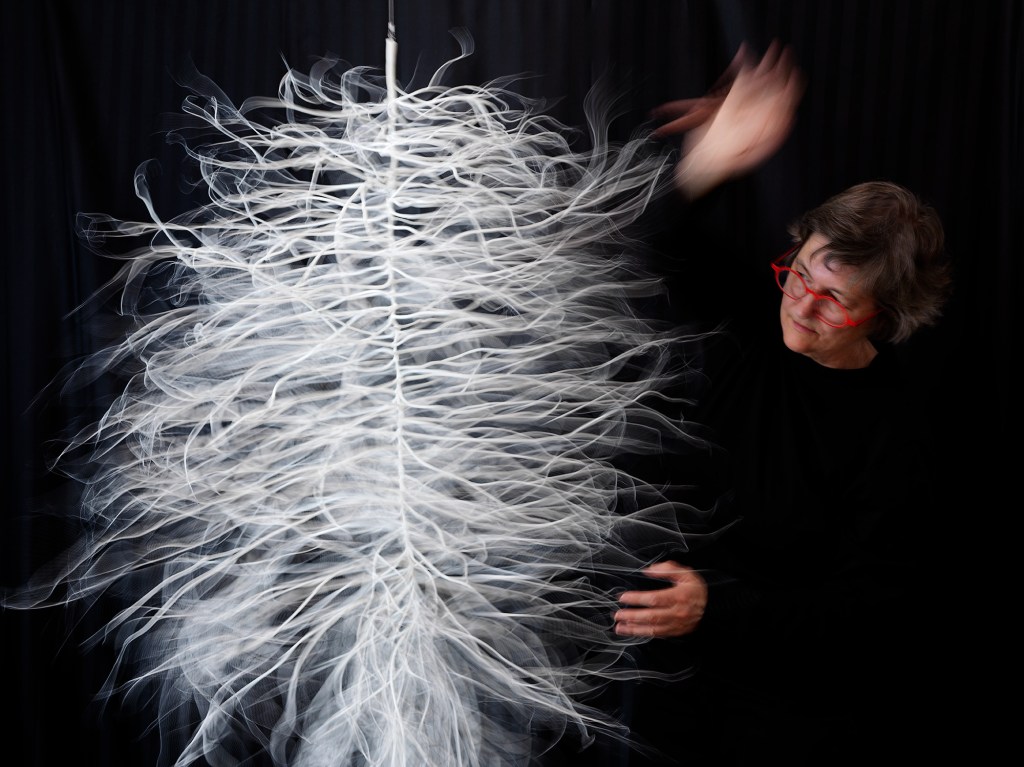
What are you most excited about as an artist for 2024?
Seeing how others approach the challenges of sharing the planet through art-making and working towards a more hopeful set of solutions with others from a range of disciplines.
I am a founding member of Gray Street Workshop. We are celebrating our 40th anniversary in 2025 with a national touring exhibition and a publication, so all of the four partners are working on major bodies of work. Full immersion, heads down!
Where can we see more of your work?
The Art Gallery of South Australia has a collection of past works and I am currently represented by Gallery Funaki in Melbourne. Also my website and Instagram.
Oakey’s exhibition Deep Rest will be presented at the Hahndorf Academy from 16 February until 17 March as part of the Adelaide Fringe. An in-conversation event with Catherine Truman will take place on 18 February, while the performance (a four-hour walking meditation within the gallery space) will be on 3 March (details here).
Visit Guildhouse for more information about Catapult mentorships.
